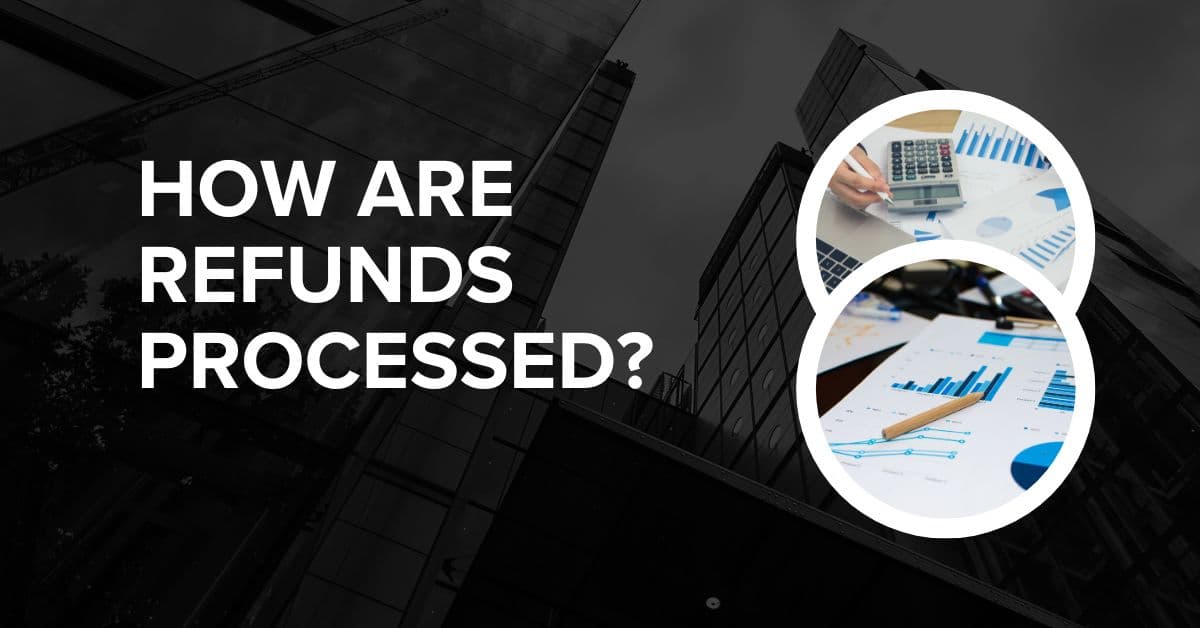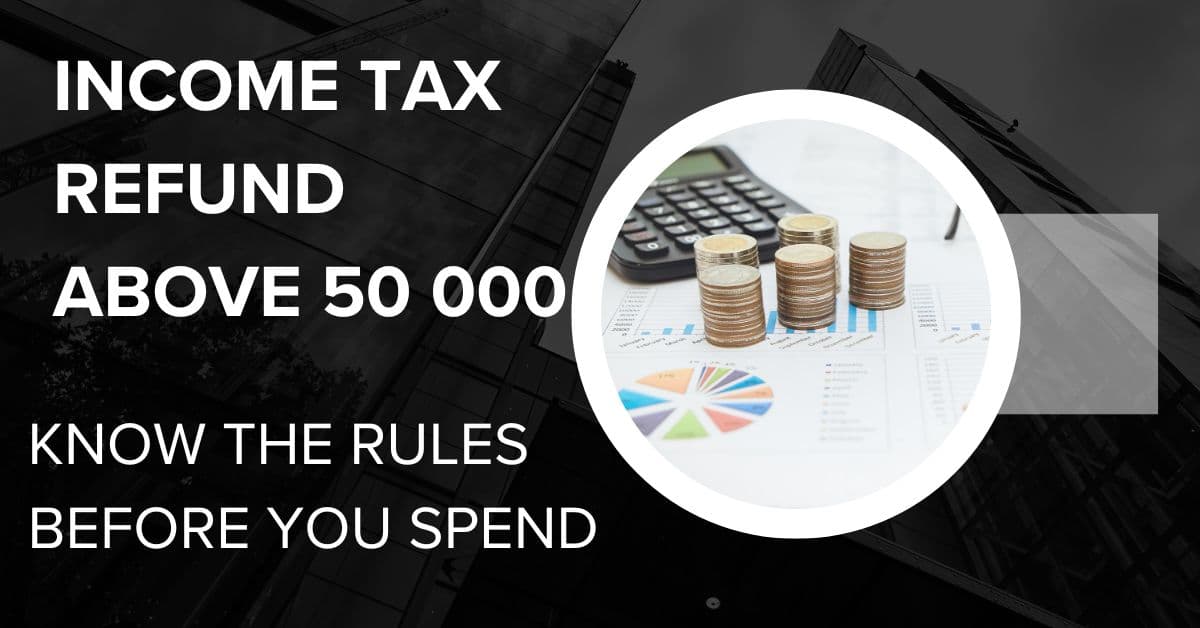Income Tax Refund Above 50 000 – A return of more than ₹50,000 in income taxes might feel like a financial windfall, particularly for Indian taxpayers who are negotiating the tax system’s intricacies. A sizable refund is a nice boost, regardless of whether it is the result of excess Tax Deducted at Source (TDS), advance tax payments, or deductions claimed under sections like 80C. To avoid problems and optimise financial gains, it is essential to comprehend the guidelines and best practices for handling such returns before you spend them all at once. Over 7.5 crore ITRs were filed digitally for the fiscal year (FY) 2024–25 (assessment year 2025–26), demonstrating the convenience of online filing [Income Tax Department]. This tutorial, which is specifically designed for new Indian taxpayers, describes what an income tax refund is, the regulations governing returns above ₹50,000, the tax ramifications, and smart ways to use your refund to ensure compliance and financial gain.
What is an income tax refund?
When your tax payment exceeds your actual tax burden for a given fiscal year, the Income Tax Department will repay the difference. This is known as an income tax refund. This may happen because of:
- Excess TDS: Usually applied to salaried persons or fixed deposit interest, employers or banks withhold more tax than you owe.
- Advance Tax: Businesses or self-employed people pay advance tax based on their expected revenue, which, if it is lower, may be more than their actual obligation.
- Exemptions and Deductions: Reducing taxable income can be achieved by claiming deductions under sections such as 80D (health insurance), 80C (up to ₹1.5 lakh for investments like PPF or ELSS), or 24(b) (home loan interest).
- Error in Tax Calculation: Tax computation errors include overpayment as a result of inaccurate TDS rates or calculations.
For example, you are entitled to a ₹50,000 refund if your employer deducts ₹1 lakh in TDS from your ₹8 lakh pay, but your tax liability is ₹50,000 following a ₹1.5 lakh Section 80C deduction. Accurate bank information is crucial since refunds are credited straight to the bank account linked to your PAN.
How are refunds processed?
Your tax due is determined by the Income Tax Department when you file your Income Tax Return (ITR). A refund is given if the amount of tax paid (via TDS, advance tax, or self-assessment tax) is more than what you owe. The procedure entails:

- ITR filing: By September 15, 2025, for FY 2024–2025 (AY 2025–2026), file your ITR via the [Income Tax e-filing portal] or on websites such as [ClearTax] or [Tax2win].
- Processing: Using information from the Annual Information Statement (AIS) and Form 26AS (TDS/TCS details), the department confirms your return, usually in 1-3 months.
- Refund Issuance: Your PAN-linked bank account receives the refund. Under Section 244A, the department pays interest at a rate of 6% annually if the deadline is missed.
- E-Verification: To finish the procedure, use your Aadhaar OTP, net banking, or Digital Signature Certificate (DSC) to validate your ITR within 30 days. Returns that have not been confirmed are considered invalid.
| Step | Description |
| File ITR | Submit ITR online by September 15,2025, with accurate and deduction details. |
| Processing | Department verifies return against Form 26AS and AIS, typically within 1-3 months. |
| Refund Issuance | Credited to Pan-linked bank account, with 6% interest if delayed. |
| E-Verification | Verify within 30 days using Aadhaar OTP |
Special considerations for refunds above ₹50,000
Although there aren’t any restrictions that apply just to refunds over ₹50,000, bigger returns could be subject to further examination in order to guard against fraud or mistakes. The Department of Income Tax may:
- Check Bank Information: To prevent delays or rejections, make sure the bank account associated with your PAN is correct and pre-validated.
- Request Additional Documentation: In order to verify the legality of large refunds, the department may request identification verification or documentation of deductions (such as Form 16 investment receipts).
- Scrutiny Under Section 143(1): Examination Large refunds may result in a preliminary assessment notice under Section 143(1), and if inconsistencies are discovered, you will need to reply with supporting documentation.
- Taxable Interest: In the year of receipt, interest resulting from processing delays (6% annually) is taxable as “Income from Other Sources” if it is included in the refund. For example, you must report ₹2,000 in your next ITR if you receive a ₹50,000 return with ₹2,000 in interest.
To avoid problems:
- Verify your ITR’s PAN, Aadhaar, and bank account information twice.
- For a minimum of seven years, keep track of any claimed deductions (such as Form 16 and PPF receipts).
- To avoid reassessment letters, make sure all sources of income—including interest and capital gains—are declared.
Tax implications of receiving a refund
Since it is a return of your unpaid taxes, receiving an income tax refund does not result in further taxes. Nonetheless, there are significant tax implications to take into account:
- Taxable Interest on Refunds: Section 244A taxes interest paid on postponed refunds at a rate of 6% annually as “Income from Other Sources” in the year of receipt. For instance, you must submit ₹2,000 in your next ITR, taxed at your slab rate (for instance, 12.5% for ₹10 lakh income, saving ₹250) if your ₹50,000 refund contains ₹2,000 in interest.
- ITR accuracy: If income is underreported or excessive deductions are claimed, Section 143(3) may result in reassessment letters, which require restitution of the refund together with interest (8% annually under Section 234B) and penalties equal to 50% of the tax avoided.
- Foreign Income: Make sure double taxation avoidance agreements are followed and submit Form 67 to obtain foreign tax credits if your refund is related to foreign income.
To reduce the risks:
- To make sure all TDS and income information match, reconcile your ITR with Form 26AS and AIS.
- Utilise tools such as [ClearTax] to reduce mistakes and auto-fetch data.
- To ensure accuracy in complex circumstances like capital gains or foreign income, consult a chartered accountant (CA).
Financial Planning with Your Refund
A refund of more than ₹50,000 is a substantial chance to strengthen your financial situation. Take into account these clever tactics designed for Indian homes rather than making rash purchases:

1. Pay Off Debt with High Interest Rates
Compared to investment returns (~8–12%), high-interest debts such as credit cards (20–40%) or personal loans (10–20%) can deplete your funds more quickly. First, pay off these bills using your return.
- For example, paying off a ₹50,000 credit card debt at 36% interest results in an annual interest savings of ₹18,000, which is significantly more than the yields on savings accounts (3–4%).
2. Establish or Grow an Emergency Fund
Reliance on loans during emergencies is avoided by having an emergency fund that covers three to six months’ worth of spending (for example, ₹1.5 to ₹3 lakh for ₹50,000 monthly costs).
- How to Start: Transfer your return to a high-yield savings account that offers 3–4% interest, such as [HDFC Bank] or [SBI].
- For example, a ₹1.5 lakh emergency fund may be started with a ₹50,000 return and completed in 20 months with ₹5,000 monthly payments.
3. Make Use of Tax-Saving Tools
If your return is received before March 31, 2025, use it to lower your tax burden for FY 2024–2025 by investing it in Section 80C tax-saving alternatives up to ₹1.5 lakh:
- Equity-Linked Savings Scheme (ELSS): The Equity-Linked Savings Scheme (ELSS) has a three-year lock-in period and offers yields of 12–15% [Groww].
- Public Provident Fund (PPF): 7.1% tax-free returns and a 15-year lock-in are offered by the Public Provident Fund (PPF) [Policybazaar].
- National Savings Certificates (NSC): 5-year lock-in, 7.7% interest rate.
- Example: Long-term objectives might be supported by investing ₹50,000 in ELSS at 12%, which could increase to ₹1.2 lakh in ten years.
4. Save for Long-term Goals
Make use of your refund to finance significant objectives like retirement, children’s education, or property ownership:
- Mutual Funds: Over a period of ten or more years, SIPs in equity funds through [Paytm Money] may generate returns of 12–15%.
- Fixed Deposits: For five to ten years, joint FDs with [SBI] provide yields of six to seven percent.
- For example, a 12% mutual fund investment of ₹50,000 may increase to ₹1.55 lakh in ten years, which would cover a child’s schooling.
5. Avoid Excessive Spending
Are you tempted to spend money on a trip or a new gadget? Put financial stability ahead of instant satisfaction. To avoid regret, apply the 24-hour rule and wait a day before buying non-essential purchases.
Implementing effective saving techniques can result in large financial rewards over time. To start saving ₹10,000 to ₹20,000 a year, pay off high-interest debt first. For instance, pay off a ₹50,000 credit card amount at 36% interest. You may ensure ₹50,000 to ₹1.5 lakh in financial safety by creating an emergency fund of ₹50,000 and increasing ₹5,000 per month. If you invest ₹50,000 within the 12.5% tax bracket, you may save between ₹18,750 and ₹37,500 in taxes each year by investing in tax-saving products like ELSS. Align with long-term financial objectives to create wealth; for example, a ₹50,000 investment in mutual funds with a 12% compound annual growth rate might increase to ₹1–₹2 lakh in ten years. Additionally, you may save ₹5,000 to ₹20,000 a year by avoiding impulsive purchases like a ₹10,000 gadget.
Common Mistakes To Avoid
If not managed smartly, getting a sizable return might result in financial blunders. The following are typical errors and ways to prevent them:

1. Paying for Everything at Once:
- Mistake: Using the return as more cash and going on lavish purchases or trips.
- Solution: The 50/30/20 guideline (50 percent necessities, 30 percent wants, and 20 percent savings or debt repayment) should be used to plan your expenditures. Set aside a minimum of 20% of the reimbursement for investments or savings.
2. Not Checking the Amount of the Refund:
- Mistake: Accepting the reimbursement without verifying that it corresponds with your ITR claim might result in fraud or other mistakes.
- Solution: Verify the refund amount on the e-filing site by comparing it to your ITR-V and Form 26AS. Use [CPC Bangalore] to report inconsistencies to the Income Tax Department.
3. Taxable Interest Ignored:
- Mistake: Ignoring refund interest and running risk of fines in the next year’s ITR.
- Solution: Use programs like [Tax2win] to accurately calculate interest (e.g., ₹2,000 on a ₹50,000 refund) and include it as “Income from Other Sources” in your ITR.
4. Using It for Short-term Pleasure
- Mistake: Spending money on things that aren’t absolutely necessary without taking care of debt or savings.
- Solution: To improve financial stability, give long-term investments or the repayment of high-interest debt first priority.
5. Ignoring Tax Planning
- Mistake: Regularly getting sizable refunds for overpaying taxes, which suggests inadequate tax preparation.
- Solution: To minimise overpaying, work with your employer to modify TDS or make an early investment in tax-saving products.
Frequently Asked Questions (FAQs)
1. Are there any additional rules for refunds exceeding ₹50,000?
Although there are no special regulations, bigger returns could be scrutinised more closely in order to stop fraud. Make sure your bank information is correct, and e-verify it within 30 days.
2. Are tax refund interest payments taxable?
According to your slab rate [ClearTax], refund interest is indeed taxed as “Income from Other Sources” in the year of receipt.
3. How much time does it take to get your money back?
usually between one and three months following e-verification, however more checks may cause bigger refunds to take longer.
4. What happens if I don’t get my money back?
Verify bank information and check the refund status on the [e-filing portal]. Get in touch with CPC Bangalore if problems continue.
5. Can I save taxes by investing my refund?
Yes, you can lower your FY 2024–2025 tax burden by investing in Section 80C alternatives like ELSS or PPF if you get them before March 31, 2025.
An Example from Real Life
Scenario: Because of excessive TDS and Section 80C deductions, Afreen, a 30-year-old professional in Bengaluru who makes ₹8 lakh a year, receives a refund of ₹60,000, which includes ₹2,000 interest.
- Action: In order to save ₹10,800 a year, she pays off a ₹30,000 credit card outstanding at 36% interest, invests ₹20,000 in a Nifty 50 index fund with [Groww], and confirms the refund amount on the [e-filing portal]. In her next ITR, she uses [Tax2win] to submit ₹2,000 in interest.
- Result: Afreen improves her financial security by avoiding tax fines, saving ₹10,800 in interest, and growing her investment to ₹48,000 in ten years at 12%.
Conclusion
If you receive an income tax return of more than ₹50,000, you have a great chance to improve your financial situation, but you must prepare carefully to prevent frequent mistakes. To remain in compliance, make sure your ITR is correct, confirm your bank information, and report any interest on your taxable refund. Make prudent use of the return by investing in tax-saving products like PPF or ELSS, paying off high-interest loans, or creating an emergency fund. To maximise your refund, begin preparing now using programs like [ClearTax] or [Tax2win], file by September 15, 2025, and speak with a financial counsellor. Spend wisely to safeguard your financial future and don’t let this fortune pass you by!
Disclaimer: Individual circumstances determine how to handle refunds and tax preparation. Before making any financial decisions, speak with a knowledgeable tax expert. The article is just meant to be instructive.
Titan Share Price Target 2025 – Should You Invest Now or Wait?
Home Loan Tax Benefits in India – Claim Section 24 + 80C Smartly
File ITR Online for Beginners – A Quick Guide

